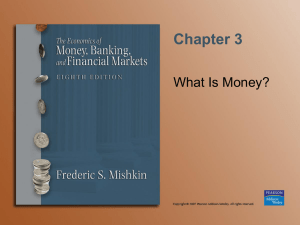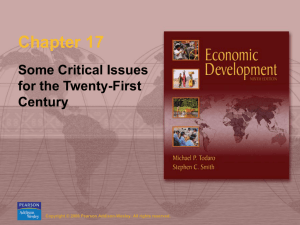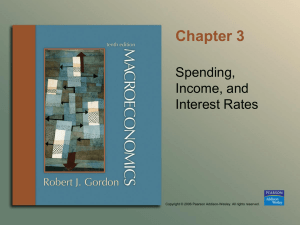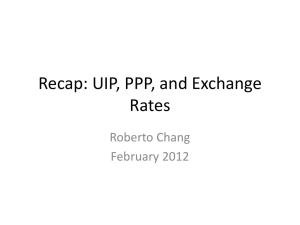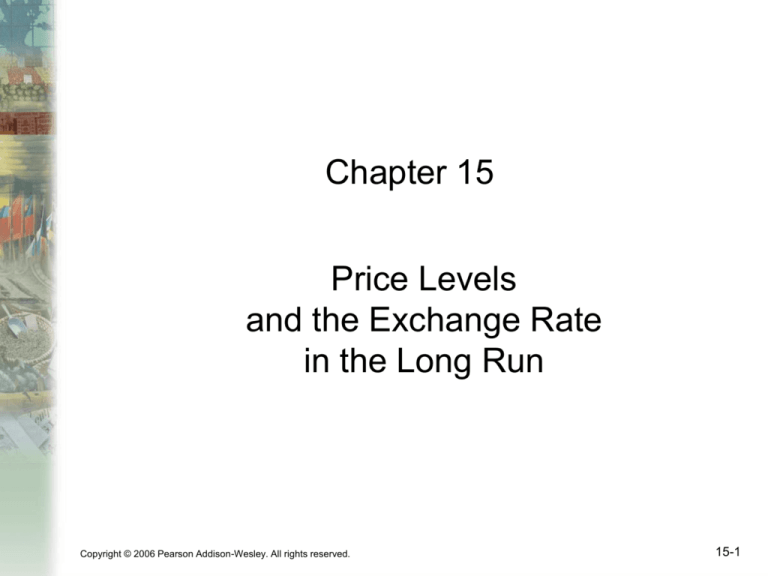
Chapter 15
Price Levels
and the Exchange Rate
in the Long Run
Copyright © 2006 Pearson Addison-Wesley. All rights reserved.
15-1
1. Preview
• Two Approaches to the Determination of FOREX Rate or E
1) Purchasing Power Parity Theory: ‘Monetary Approach’ or
‘Monetarist Approach”
2) Real Exchange Rate Analysis : Real Factor Analysis
• Both are Long -un models of exchange rates
Copyright © 2006 Pearson Addison-Wesley. All rights reserved.
15-2
2. Purchasing Power Parity:
1) Fundamental Force
Assuming that there is an equilibrating force
built into the world market economy, which
will set the equilibrium FOREX rates in such a
way that a fixed amount of a currency (say,
Canadian $) may buy the same amount of
goods anywhere in the world after the
currency conversion.
Copyright © 2006 Pearson Addison-Wesley. All rights reserved.
15-3
2) The ‘new PPP’ comes from the old ‘Law
of One Price for One Good’
• The law of one price simply says that the
same good in different competitive markets
must sell for the same price when
transportation costs and barriers between
markets are not important.
Copyright © 2006 Pearson Addison-Wesley. All rights reserved.
15-4
3) Formally, Purchasing Power Parity
• Purchasing power parity is the application of the law
of one price across countries for all goods and
services, or for representative groups (“baskets”) of
goods and services.
(ECanada$/us$) PUS = (PCanada)
PUS = price level of goods and services in the US
PCanada = price level of goods and services in Canada
ECanada$/us$ = exchange rate
Copyright © 2006 Pearson Addison-Wesley. All rights reserved.
15-5
• PPP implies that
ECanada$/us$ = PCanada / PUS
The price levels adjust to determine the exchange rate.
If the price level in the US is US$200 per basket, while the
price level in Canada is C$300 per basket, PPP implies that
the C$ /US$ exchange rate should be C$300/US$200 =
C$ 1.5 / US$ 1 = E c$/us$.
Purchasing power parity says that each country’s currency
has the same purchasing power: 1.5 Canadian dollars buy
the same amount of goods and services as does 1 US dollar,
since prices in Canada are 50% as high.
Copyright © 2006 Pearson Addison-Wesley. All rights reserved.
15-6
4) Two Versions of Purchasing Power
Parity
• Purchasing power parity comes in 2 forms:
• Absolute PPP: purchasing power parity that has
already been discussed. Exchange rates equal price
levels across countries.
E$/€ = P$/PEU
• Relative PPP: changes in exchange rates equal
changes in prices (inflation rates)
D%E$/€, = $ - EU,
where t = inflation rate
Copyright © 2006 Pearson Addison-Wesley. All rights reserved.
15-7
5) Purchasing Power Parity assumes
E$/€ = P$/PEU
E$/€ / (P$/PEU)=1 at all times
*Question: If the PPP holds in reality, what
would be the graphs of the relative price
data, Money supplies of two countries
and the FOREX rate like?
Copyright © 2006 Pearson Addison-Wesley. All rights reserved.
15-8
6) PPP is also called ‘Monetary Approach’
Holds in Long-run.
In
particular, FOREX rate is determined by
the relative price level, which is
proportional to relative money supply of
the two countries.
Assuming
no changes in real factors such
as demand or supply of goods; the only
change is due to money suppies and the
price levels.
Copyright © 2006 Pearson Addison-Wesley. All rights reserved.
15-9
Monetary Approach
to Exchange Rates (cont.)
• The exchange rate is determined in the long
run by relative prices (P/P), which are
determined by the relative supply of money
across countries across countries.
Copyright © 2006 Pearson Addison-Wesley. All rights reserved.
15-10
A Simple Math Express is:
1) Absolute PPP:
E$/€ = P$/PEU =
2) Relative PPP:
D%E$/€, = $ - EU = D%MS$- D%MSEU
Copyright © 2006 Pearson Addison-Wesley. All rights reserved.
15-11
* Monetary Approach to Exchange Rates:
Combine PPP and the Long-run MoneyPrice Relationship
a permanent rise in the domestic money supply
causes a proportional increase in the domestic price level
in the long-run;
causing a proportional depreciation in the domestic
currency (through PPP).
Copyright © 2006 Pearson Addison-Wesley. All rights reserved.
15-12
* Expectations and Depreciation feed back
to the Short-run Model through the
FOREX Market.
• If the above is repeated, now people form
expectations, linking money creation to depreciation
immediately. People develop an Expected Rise in
FOREX Rate.
• Now going back to the Short-run Interest Parity
Model(Chapter 13): In the Financial Market,
Expectations of Depreciation of Domestic Currency
cause the Expected Return on Foreign Investment to
increase, acutally making the domestic currency
depreciate immediately.
Copyright © 2006 Pearson Addison-Wesley. All rights reserved.
15-13
7) Shortcomings of PPP
• There is little empirical support for purchasing
power parity.
The prices of identical commodity baskets, when
converted to a single currency, differ substantially
across countries.
• Relative PPP is more consistent with data, but
it also performs poorly to predict exchange
rates.
Copyright © 2006 Pearson Addison-Wesley. All rights reserved.
15-14
Shortcomings of PPP (cont.)
Copyright © 2006 Pearson Addison-Wesley. All rights reserved.
15-15
Shortcomings of PPP (cont.)
Reasons why PPP may not be a good theory:
1. Trade barriers and non-tradable goods
and services
2. Imperfect competition
3. Differences in price level measures
Copyright © 2006 Pearson Addison-Wesley. All rights reserved.
15-16
Shortcomings of PPP (cont.)
• Trade barriers and non-tradables
Transport costs and governmental trade
restrictions make trade expensive and in some
cases create non-tradable goods or services.
Services are often not tradable: services are
generally offered within a limited geographic region
(e.g., haircuts).
The greater the transport costs, the greater the
range over which the exchange rate can deviate
from its PPP value.
One price need not hold in two markets.
Copyright © 2006 Pearson Addison-Wesley. All rights reserved.
15-17
Shortcomings of PPP (cont.)
• Imperfect competition may result in price
discrimination: “pricing to market”.
A firm sells the same product for different prices in different
markets to maximize profits, based on expectations about
what consumers are willing to pay.
• Differences in price level measures
price levels differ across countries because of the way
representative groups (“baskets”) of goods and services
are measured.
Because measures of goods and services are different,
the measure of their prices need not be the same.
Copyright © 2006 Pearson Addison-Wesley. All rights reserved.
15-18
2. The Real Exchange Rate Approach
to Exchange Rates
1) Introducing Real Factors
•
According to PPP, exchange rates are
determined by relative price ratios:
E$/ € = P$/P€
•
According to the more general real
exchange rate approach, exchange rates
may also be influenced by the real exchange
rate:
E$/ € = q$/ € x P$/P €, and q is not constant at 1.
Copyright © 2006 Pearson Addison-Wesley. All rights reserved.
15-19
2) Simple Definition of Real Exchange Rate
By definition, on surface,
q$/EU = (E$/€ x PEU)/P$
This is the simple definition of real exchange rate.
This is the real domestic currency price of foreign
currency.
When this falls, there is a real depreciation of FOREX,
and a real appreciation of domestic currency.
Copyright © 2006 Pearson Addison-Wesley. All rights reserved.
15-20
3) Changes in q: What do we call?
Example) Real Deprecation of FOREX or Real
Appreciation of Domestic Currency
q $/EU = (E$/€ x PEU)/P$
If the EU basket costs €100, the Canadian basket
costs $120 and the nominal exchange rate is $1.20
per euro, then the real exchange rate is 1.
If the EU basket costs €100, the Canadian basket
costs $120 and the nominal exchange rate is $1.00
per euro, then the real exchange rate is 0.82.
When q goes down, we say that there is a real
depreciation of FOREX or a real appreciation of
domestic currency: We say that the international
competitiveness of domestic good increases.
Copyright © 2006 Pearson Addison-Wesley. All rights reserved.
15-21
Real Exchange Rate Analysis of FOREX
Rate:
Note
that E and q go move together in this
case.
E
is determined by q, and q is determined
by Real Factors.
Copyright © 2006 Pearson Addison-Wesley. All rights reserved.
15-22
3) Complex Function of Real Exchange
Rate
What influences the real exchange rate?
Relative Sizes of International Demand and Domestic Supply that
affect Supply of and Demand for FOREX in the country
q
= f( International Excess Demand(-);
Increased Domestic Supply to the World(-))
= f (Net Exports(-))
= f (Net Demand for Domestic Goods)
=f (Net Supply of FOREX)
=f(Current Account Surplus)
Copyright © 2006 Pearson Addison-Wesley. All rights reserved.
15-23
* Japan in the 1970s and 80s.
• International Demand
• Japanese Supply – Technical Innovation
• Current Account Surplus
• E
• q
Copyright © 2006 Pearson Addison-Wesley. All rights reserved.
15-24

